| |
|
|
Thank God I am black. White people
will have a lot to answer for at the last judgement.
|
|
Desmond Tutu (1931- ), Archbishop
of Cape Town, South Africa
|
The idea that racial or ethnic groups should be persecuted
is popular in the Bible. God himself was keen on exterminating
whole peoples, such as the Amalekites (1 Samuel 15:3). Believing
that they had replaced the Jews as God's chosen people, Christians
deduced that they were free to persecute and extirpate non-Christian
peoples, and even that they were under a moral obligation to
do so.
|
For traditional Christians, black skin
was associated with evil. The devil, his demons and sub-Saharan
Africans all owed their black skin to having been cursed
by God.
|
|
|
When the Jews and Moors were expelled from Spain towards the
end of the fifteenth century, racial legislation was passed
to "purify" the blood of the upper classes. Anyone
with Jewish or Moorish blood was suspect and penalised. Under
statutes of limpieza de sangre, the descendants of
Jews and Moors, even though they were Christians, were debarred
from universities, religious orders, military orders and public
office. In theory anyone who had any Jewish or Moorish ancestor,
however remote, was of "impure blood" and suffered
accordingly. Such people were second class citizens. Moreover
they were second class citizens for racial, not religious, reasons.
There was no question about it: according to the rules even
the most devout Christian should be punished for having even
a single distant ancestor of the wrong race.
The earliest known case judging Limpieza de Sangre comes from
the Church of Cordoba. It explained the procedure to judge the
purity of blood of a candidate as follows:
Kneeling, with his right hand placed over the image of a
crucifix on a Bible, the candidate confirmed not being of
either Jewish or Moorish extraction. Then the candidate provided
the names of the parents and grandparents, as well as places
of birth. Two delegates of the council, church or other public
place would then research the information to make sure it
was truthful. If the investigation had to be carried out of
Cordoba, a person, not necessarily a member of the council,
would be appointed to examine the witnesses appointed by the
candidate. This researcher would receive a sum per diem according
to the rank of the person, the distance traveled and the time
spent. Having collected all the reports, the secretary or
the notary must read them all to the council and a vote would
decide whether the candidate was approved. A simple majority
was sufficient, after which the candidate had to promise to
obey all the laws and customs of the Church.
Sicroff, Albert A.. Los estatutos de Limpieza de Sangre.
p. 121.
This idea was endorsed and promoted by the Roman Catholic Church.
Limpieza de sangre rules were set out and enforced
by priests and bishops, monks and abbots. In 1496, Pope Alexander
VI approved a purity statute for the Hieronymite Order, an enclosed
religious Order. Other statutes regulated other religious Orders,
the priesthood, Christian guilds, schools, and military and
government offices.
Tests of limpieza de sangre began to lose their utility
by the 19th century, but in certain religious contexts they
continued. An edict of 8 March 1804 by King Ferdinand VII resolved
that no knight of the Military Orders could wed without having
a council vouch for the limpieza de sangre of his prospective
spouse. In some places second class citizens were obliged to
intermarry well into the nineteenth century because ecclesiastical
authorities refused licences for "mixed marriages".
Candidate for the priesthood still had to show purity of blood
going back four generations.
Limpieza de sangre entry requirements for the Spanish
Army and Navy were abolished in 1865, In November the same year,
a decree allowed children for whom ancestry could not be verified,
to enter religious establishments of higher education. In 1870
a decree suppressed all use of blood purity standards in determining
eligibility for any government position or licensed profession.
Less formalised discrimination was still present well into the
20th century. In Majorca for example, xuetas, people descended
from conversos and who would have failed the blood purity tests
were still considered second class. No xueta priest was allowed
to say Mass in a cathedral until the 1960s.
The Cagots
The Cagots provide an insight into Christian discrimination,
apartheid, and persecution because they were ordinary Catholics
persecuted by Catholics*.
Cagots were perfectly orthodox. No hint of heresy attached to
them. They lived ordinary lives as far as they were allowed
to and spoke the local language of where they lived. Their origins
are unknown and as far as we know they were persecuted for no
better reason that it was traditional to persecute them.
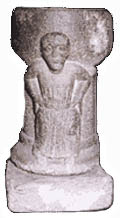  The
Cagots of France were one of the groups persecuted by Christians
for centuries, but now almost forgotten. Evidence of the Cagots
exists back as far as AD 1000, though their origins are lost
to history. In western France and northern Spain they were regarded
as an inferior caste of humans, even sub-humans. In medieval
times Cagots are recorded by different names such as Gahets,
and Gafets in Gascony; Agotes, Agotac, and Gafos in the Basque
country; Capots in Anjou and Languedoc; and Cacons, Cahets,
Caqueux, and Caquins in Brittany. The
Cagots of France were one of the groups persecuted by Christians
for centuries, but now almost forgotten. Evidence of the Cagots
exists back as far as AD 1000, though their origins are lost
to history. In western France and northern Spain they were regarded
as an inferior caste of humans, even sub-humans. In medieval
times Cagots are recorded by different names such as Gahets,
and Gafets in Gascony; Agotes, Agotac, and Gafos in the Basque
country; Capots in Anjou and Languedoc; and Cacons, Cahets,
Caqueux, and Caquins in Brittany.
These Cagots were a race of pariahs, 'pestiferous people',
repressed for a thousand years as untouchables. Their history
is obscure. Today hardly anyone will talk about it. Surviving
Cagots are ashamed of their untouchable past. The French are
ashamed of what they and their Church did.
The Cagots were not a religious group, nor apparently an ethnic
group. They spoke the same language as the people in their area
and generally kept the same religion as well, generally Roman
Catholicism, but in some places after the Reformation, Protestantism.
Their only distinguishing feature was their descent from families
identified as Cagot.
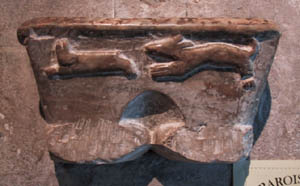  Cagots
were supposed to have strange heads, webbed feet and misshapen
ears. ‘Cagot ear’ is a medical term used today for
ears without earlobes. Cagots
were supposed to have strange heads, webbed feet and misshapen
ears. ‘Cagot ear’ is a medical term used today for
ears without earlobes.
The Roman Catholic Church was foremost in the persecution of
Cagots, even though the Cagots themselves were Roman Catholics.
In churches they were obliged to use their own water fonts,
not the normal font reserved for “clean” Catholics.
In the 18th century a wealthy Cagot in the Landes region was
caught using the font reserved for "clean" Catholics.
His hand was chopped off and nailed to the church door*.
Cagots sat in their own segregated pews. When the priest gave
communion he would throw the blessed host to them as though
they were dogs. Some kinder priests used a long wooden spoon,
still avoiding the touch of the outcasts. It was a crime for
Cagots to drink from the same communion cup as non-Cagots during
the periods when wine was permitted to the laity. They also
had their own church doors. These doors were usually built so
low that Cagots were forced to stoop as they entered, giving
a visible sign of their subservient status. At least 60 Pyrenean
churches still have Cagot entrances.
Attempts to stop the discrimination and cruelty had no effect,
and were ignored by local authorities and church authorities
alike*. Cagots were excluded
from all political and social rights. They were forced to be,
as the bible put it, “drawers of water and hewers of wood”.
(The same biblical verse was used elsewhere in the world by
Christians to justify slavery). They were restricted to certain
trades: carpentry, butchery, and rope-making – curiously
reminiscent of the restricted trades of Indian Untouchables.
They made coffins for the dead. They also became roofers and
expert woodworkers who built many of the Pyrenean churches from
which they were themselves partly excluded. Their geographical
spread is probably linked to the St James of Compostella pilgrim
routes where their building services would be most needed.
They seem to have been allowed certain restricted land, but
penalties were severe if they ever presumed to farm land outside
of their limits. A Cagot who dared to farm the fields outside
of these limits had his feet pierced with hot iron spikes. Other
limitations were also strictly enforced. Some offenders were
burned at the stake for failing to obey the apartheid laws.
At Lourdes, any Cagot who broke the rules had two strips of
flesh, each weighing two ounces, torn from sides of his spine.
Apartheid continued even after death. Cagots were buried in
their own distinct cemeteries on the northern side of the church
(there is still one in Bentayou-Sérée a village
north of Pau near the Spanish border).
Cagots were charged with the usual range of accusations levelled
by the Church against those it did not like. Cagots were mentally
defective, they were physically deformed, they were diseased,
they were sexually rapacious, they were criminals and they were
cannibals. Some said they were bisexual. Some that they had
magical powers. They were said to emit enough body heat to shrivel
an apple merely by holding it. Some claimed said that Cagot
veins ran with green blood and that this blood which oozed from
their navels on Good Friday. (We know from a few genuine medical
investigations that Cagots were in fact perfectly normal).
They were obliged to live in poor unhealthy areas segregated
from everyone else, just as elsewhere the Church forced Jews
to live in ghettos. Cagot ghettoes were known as Cagoteries.
Traces of them can still be found in Pyrenean villages (good
examples are Campan and Hagetmau).
Like Jews, Cathars and heretics they were forced to wear identifying
yellow badges Gagots were obliged to wear a yellow or red goose's
or duck’s foot conspicuously pinned to their clothes -
symbolising their own supposedly webbed toes. They were sometimes
called canards from their duck’s-foot badges. This ancient
practice of forcing minorities to wear identifying coloured
badges was, like many other Christian practices, later consciously
copied by the Nazis. By copying Church practices they successfully
claimed to be following a respectable Christian tradition.
Cagots were permitted to marry only other Cagots. Marriage
between Cagots and clean Catholics was unthinkable, and there
are songs surviving from the 16th and 17th centuries lamenting
tragic misalliances.
When Cagots came into a town they had to warn of their presence
by shaking a rattle, just as lepers warned of their arrival
by ringing a bell. So pestilential was their touch that it was
a crime for them to walk barefoot, which gave credence to the
fable that they had webbed toes. They were not allowed to touch
the parapets of bridges. They were allowed to enter markets
on certain days, usually Mondays, so that others would know
when to stay indoors to avoid being polluted. If they risked
the wrong day to go to market they could be brutally punished,
beaten and flogged back to their ghettoes.
They were not allowed to walk in the middle of the street.
If they encountered a normal clean person, they had to shrink
to the side of the road, and stand quiet and silent in the gutters.
They were forbidden to carrying knives or other weapons and
were obliged to wear hoods to hide their faces. Eating or bathing
with normal “clean” Christians was forbidden. They
could not even use the same baths as other people.
During the French Revolution, the laws against Cagots were
formally abandoned by the new secular government. After 1789
many emigrated to escape the hatred and abuse which persisted
in the countryside. Those that remained slowly assimilated into
the general populace. Francisque Michel's Histoire des races
maudites (History of the Accursed Races), published
in 1847 was one of the first studies of the Cagots. Michel found
at least 10,000 Cagots still scattered across Gascony and Navarre,
and still suffering repression nearly 70 years after apartheid
and persecution had been officially banned. It seems finally
to have disappeared just as the Church is loosing its last vestiges
of influence in the French countryside.
Non-Europeans
The prevailing Christian view by the end of the Middle Ages
was that non-Europeans were inferior creatures. The Roman Catholic
Church debated for a long time whether newly discovered peoples
around the world were even human. The problem was that there
was no way of establishing whether or not they possessed souls.
Indigenous peoples of the Americas were a particular problem
because they clearly had a high culture of their own, and the
Roman Catholic Church debated with itself for a long time over
their exact nature.
When a debate held in 1550 at Valladolid in Spain led to the
conclusion that they might indeed be fully human, it became
difficult to justify keeping them in slavery. The short-term
solution was a system that was not called slavery but still
amounted to slavery. The long-term solution was to import slaves
bought in Africa. No one in Christendom seems to have worried
about the morality of enslaving Africans.
Anti-Semitism
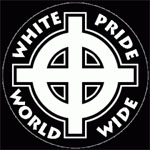  Anti-Semitism
was also characteristically Christian. Hatred of the Jews had
been fostered by the Church for centuries, and was opposed by
freethinkers. Traditional Christian teachings have been anti-Semitic.
Jews were persecuted for centuries by the mainstream Churches
using exactly the same arguments, and drawing exactly the same
conclusions, as the Nazis did later. Many anti-Semitic racist
groups still flourish on a diet of Christianity*,
and affirming Christian belief is a membership requirement in
most of them throughout the western world. Anti-Semitism
was also characteristically Christian. Hatred of the Jews had
been fostered by the Church for centuries, and was opposed by
freethinkers. Traditional Christian teachings have been anti-Semitic.
Jews were persecuted for centuries by the mainstream Churches
using exactly the same arguments, and drawing exactly the same
conclusions, as the Nazis did later. Many anti-Semitic racist
groups still flourish on a diet of Christianity*,
and affirming Christian belief is a membership requirement in
most of them throughout the western world.
Click on the following link for more on Christian
anti-semitism
Racism and Colonisation
The Anglican Church was concerned about mental capacity, and
wary of trying to bring Christianity to people who might not
be able to understand it. The most common view amongst Christians
had been made explicit by the Barbados Assembly in 1681, when
it stated of black slaves that "Savage Brutishness renders
them wholly uncapable" of being converted*.
Most Christian slave owners had no doubt that the Assembly was
right. There was however a lively debate, mainly among senior
Anglicans, about the theological justification for converting
slaves. It was commonly held that any drive towards conversion
should be tailored towards their greatly inferior mental capacities.
Fed an appropriate diet of quiescent theology, blacks could,
it was claimed, become perfect slaves: compliant, accommodating
and socially calm. But this view was not universal amongst the
slave masters, and few slaves were converted*.
One problem with converting slaves was the danger that some
of them might win a place among the elect. As one slave owner
asked "Is it possible that any of my slaves could go to
Heaven, and must I see them there?"*.
|
A popular African complaint, attributed
variously to
Jomo Kenyatta, President of Kenya, and to Archbishop Desmond
Tutu;
|
“When the Missionaries arrived, the Africans
had the land and the Missionaries had the Bible. They
taught how to pray with our eyes closed. When we opened
them, they had the land and we had the Bible.”
|
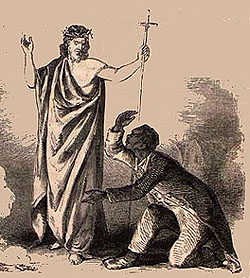  One
reason why Christianity found it so difficult to make voluntary
converts around the world was that it was so difficult for locals
to become priests. They were usually denied the right to learn
Latin or read the Bible, and therefore could not hope for a
career in the Church. The few who did could not hope to become
bishops, largely because European priests were not prepared
to serve under them. Such racism limited the spread of Christianity
in many places, but most notably in India. One
reason why Christianity found it so difficult to make voluntary
converts around the world was that it was so difficult for locals
to become priests. They were usually denied the right to learn
Latin or read the Bible, and therefore could not hope for a
career in the Church. The few who did could not hope to become
bishops, largely because European priests were not prepared
to serve under them. Such racism limited the spread of Christianity
in many places, but most notably in India.
In Africa the Churches changed their approaches in the twentieth
century. East Africa saw its first black Roman Catholic bishop
in 1939, and its first black Anglican bishop in 1947.
The belief of European Christians that other races were inferior
led to colonisation and large-scale abuse. The extirpation of
native peoples in the Americas, Australasia, and elsewhere was
of little consequence since these peoples were only pagans and
might not even possess souls. They were slaves by nature. God
had made them like that. Christian scholars and pseudo-scientists
concurred. Sample non-Christians were kept in Western zoos in
the nineteenth century. There was an Australian aborigine in
London Zoo. A Congolese pygmy named Ota Benga shared a cage
with an orang-utan in the Bronx Zoo as late as 1906*.
|
Ota Benga photographed while still an
exhibit in Bronx Zoo
|
|
|
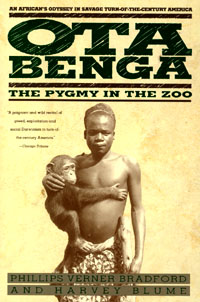  Colonisation
by European powers was seen as a God-given opportunity for spreading
the gospel to the heathen. It was a Christian duty, even when
it led to the deaths of millions. God encouraged colonisation.
He showed the way. He spoke to churchmen. He cleared the path
for colonialists. His Churches were keen to convert or replace
native heathen populations. Both Roman Catholic and Protestant
Churches encouraged colonialism. Typically, in Africa, missionaries
would advance into new territories. Sooner or later they would
sow discord, encouraging rebellion against unsympathetic local
rulers. When bloodshed followed, the Churches would appeal to
European governments to intervene, and another territory would
be annexed. This process seems to have accounted for more than
half of the European colonies in Africa. As one historian puts
it: Colonisation
by European powers was seen as a God-given opportunity for spreading
the gospel to the heathen. It was a Christian duty, even when
it led to the deaths of millions. God encouraged colonisation.
He showed the way. He spoke to churchmen. He cleared the path
for colonialists. His Churches were keen to convert or replace
native heathen populations. Both Roman Catholic and Protestant
Churches encouraged colonialism. Typically, in Africa, missionaries
would advance into new territories. Sooner or later they would
sow discord, encouraging rebellion against unsympathetic local
rulers. When bloodshed followed, the Churches would appeal to
European governments to intervene, and another territory would
be annexed. This process seems to have accounted for more than
half of the European colonies in Africa. As one historian puts
it:
... by the middle of the twentieth century, an era marked
by civil rights movements, anti-colonialism, and growing secularization,
missionaries were viewed quite differently. Instead of godly
martyrs, historians now described missionaries as arrogant
and rapacious imperialists. Christianity became not a saving
grace but a monolithic and aggressive force that missionaries
imposed upon defiant natives. Indeed, missionaries were now
understood as important agents in the ever-expanding nation-state,
or “ideological shock troops for colonial invasion whose
zealotry blinded them."*
Churches were often guilty of complicity in massacres and atrocities
resulting from colonial policy. For example King Leopold was
granted control of the Congo in 1885 explicitly to bring Christianity
to the benighted heathen. The atrocities perpetrated by his
government in the Belgian Congo — the extensive use of
slave labour and assorted murderous practices — were first
concealed then minimised by the Roman Church. (The family of
Ota Benga mentioned above had been massacred by Leopold's Christian
forces)
|
Christian era Belgian Congo
Chidren had their hands cut off if they failed to work
hard enough for their Catholic masters
Yoka (standing) had his right hand cut off. Mola (seated)
lost both hands to gangrene after they were bound so tightly
as to cut off the blood supply.
Equateur, Congo Free State, circa 1905.
|
|
|
| |
|
|
The truth about the Congo was published and international opinion
mobilised by nineteenth century freethinkers. Indeed, almost
the only criticism of colonisation and its evils came from freethinkers.
The most notable critics were Thomas Paine in the eighteenth
century and George Holyoake in the nineteenth, but their views
were generally regarded as wicked, sinful and contrary to God's
will. Colonisation was regarded by almost all Christians as
wholly good, divinely sanctioned and necessary, well into the
twentieth century. European children were removed from their
mothers and sent out to the colonies to help stock these new
lands. The children of single mothers in Britain, for example,
were often entrusted to Church charities that informed the children
they were orphans and sent them to Canada, Australia, New Zealand
and other colonies. As the Archbishop of Perth pointed out in
1938 "If we do not supply from our own stock, we are leaving
ourselves all the more exposed to the menace of the teeming
millions of our neighbouring Asian races"*.
|
The penitential garb associated with
the Christian persecution of
Jews, Moslems, heretics and atheists in Spain, is still
in popular use.
|
|
|
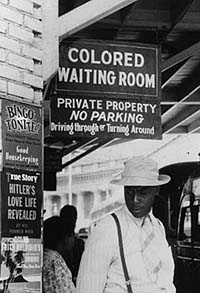  Long
after public opinion had forced Christians to abandon the practice
of slavery, the prevailing orthodoxy was that non-whites were
inferior spiritually, morally, and mentally. Once again the
Bible was cited as proof. A favourite prooftext was "Let
them live; but let them be hewers of wood and drawers of water....
" (Joshua 9:21). All Churches maintained systems of racial
discrimination and sustained them well into the twentieth century,
including segregated churches and church schools. Racial segregation
was opposed largely by atheist intellectuals and other freethinkers.
It was not bishops or clergymen but unbelievers like Bertrand
Russell who spread the idea that all should be treated equally. Long
after public opinion had forced Christians to abandon the practice
of slavery, the prevailing orthodoxy was that non-whites were
inferior spiritually, morally, and mentally. Once again the
Bible was cited as proof. A favourite prooftext was "Let
them live; but let them be hewers of wood and drawers of water....
" (Joshua 9:21). All Churches maintained systems of racial
discrimination and sustained them well into the twentieth century,
including segregated churches and church schools. Racial segregation
was opposed largely by atheist intellectuals and other freethinkers.
It was not bishops or clergymen but unbelievers like Bertrand
Russell who spread the idea that all should be treated equally.

|
The Philippine-American War (1899-1902)
was inspired by God, who mentioned His idea to President
Wilson. This is a cartoon on the front page of the New
York Evening Journal on 5 May 1902, reporting the
order of General Jacob H. Smith to kill Filipinos over
ten years old - an cartoon that resulted in an investigation
and the General's court martial.
|
|
|
Black Africans.
Buying and selling existing slaves was always perfectly acceptable
to Christians, since the Bible specifically permitted it, and
set out a number of rules to regulate it. Christians had a few
theoretical rules about slavery, for example Christians should
not in theory have enslaved other Christians unless they were
prisoners taken in battle. In practice these rules were highly
flexible, and the Church itself frequently condemned people
to slavery. There was no question about the bible's support
for slavery, but when widespread slavery became rare during
the Enlightenment, it now became necessary to justify specifically
Black Slavery. Fortunately there were some convenient ancient
Christian traditions.
The first justification came from a biblical character called
Phinehas. The biblical Phineas executed an Israelite man and
a Midianite woman while they were together in the man's tent,
running a spear or lance through the man and the belly of the
woman. This double killing ended a plague sent by God to punish
the Israelites for sexually intermingling with the Midianites,
engaging in idolatrous practices brought in by Midianite women,
and stopping the desecration of God's sanctuary. For his actions
Phineas is commemorated as a saint in the Eastern Orthodox Church
on September 2. Phinehas, was cited by the promoters of laws
banning interracial marriages, and his name was used by Christian
Identity groups, such as the Phineas Priesthood.
A second justification came from another biblical character,
Ham, one of the sons of Noah. Ham committed some unspeakable
sexual crime against his father Noah (Gen. 9:20-27). For this
crime Noah cursed Ham's son Canaan. The narrative was interpreted
by Jews, Christians and Muslims as an explanation for Canaan
and his descendants being inferior beings, having black skin,
and being suited to lives of slavery. The Curse of Ham
was frequently cited as the biblical justification for imposing
eternal slavery upon black people, and black people alone.
|
Christians argued the theological point
whether negros were descended from Ham,
but even if they weren't, a negro was still a beast
"created witharticulate speach and hands, that he
may be of service to his master - the White man"
|
|
|
The biblical explanation that black Africans, as the "sons
of Ham", were cursed, possibly "blackened" by
their sins, was cited during the Middle Ages. It became increasingly
common during the Christian slave trade of the 18th and 19th
centuries. It was still a popular idea after the end of slavery
in the west, and some denominations retained the idea well into
secular times. Leaders of The Church of Jesus Christ of Latter-day
Saints taught that Black Africans were under the Curse of
Ham. For this reason, Brigham Young held that Black people
were banned from the Priesthood. In 1978 then president of the
Church, Spencer W. Kimball, said he received a revelation that
extended the Priesthood to all worthy male members of the Church.
A third justification came from the biblical story of Cain
and Abel, where Cain is marked in some way for his crime. Early
Christianity associated the Mark of Cain with black skin,
explicit references surviving in many early texts, including
Syriac and Armenian Christianity. The idea persisted through
the Middle Ages and was used by Christian supporters of slavery..
Africans in North America and the Caribbean.
The premise behind chattel slavery in North America had been
the traditional biblical one that slaves, like women and children,
were property. As such they had few, if any, legal rights.
|
Slave Advertisement, Charleston, South
Carolina, 1780s
Slaves were regarded like livestock - healthy specimens
commanded higher prices.
|
|
|
Slave codes were effective tools against slave discontent,
particularly uprisings and runaways. Enforcement of slave codes
varied, but corporal punishment was widely and harshly employed.
The original U.S. constitution discriminated against blacks.
In 1776, seven out of the Thirteen Colonies that declared their
independence enforced laws against interracial marriage. Both
Northern and Southern states had passed further discriminatory
legislation from the early 19th century.
As the abolitionist movement gained force, concern about blacks
heightened among some whites in the North. The 1848 Constitution
of Illinois led to one of the harshest Black Code systems in
the nation until the Civil War. Indiana's 1851 Constitution
stated "No Negro or Mulatto shall come into, or settle
in, the State, after the adoption of this Constitution."
The Illinois Black Code of 1853 extended a complete prohibition
against black immigration into the state.
Some American states had passed anti-miscegenation laws, banning
the marriage of whites to blacks ("negros"), in the
18th Century these laws were justified by reference to the Bible,
particularly of the stories of Phinehas and of the "Curse
of Ham". In the nineteenth century all slave states passed
anti-miscegenation laws laws, as did new free states, including
Indiana, Illinois and Michigan, using the same biblical justifications.
Some states continued to pass such laws well into the 20th century,
|
Christian era America - Loving v. Virginia,
388 U.S. 1 (1967) was a landmark civil rights decision
of the United States Supreme Court which invalidated laws
prohibiting interracial marriage. The case was brought
by Mildred Loving, a black woman, and Richard Loving,
a white man, who had been sentenced to a year in prison
in Virginia for marrying each other. Their marriage violated
the state's anti-miscegenation statute, the Racial Integrity
Act of 1924, which prohibited marriage between people
classified as "white" and people classified
as "colored". The Supreme Court's unanimous
decision held this prohibition was unconstitutional, reversing
Pace v. Alabama (1883) and ending all race-based legal
restrictions on marriage in the United States.
|
|
|
The idea of the Mark of Cain being black skin was particularly
popular in Baptist congregations in the North American colonies,
especially in the South where segregation was almost universal.
When a split between the Northern and Southern Baptist organizations
arose over slavery and the education of slaves, the Southern
Baptist used the curse of Cain as a justification for slavery.
In the 19th and 20th centuries, Baptist ministers in the southern
United States taught that there were two separate heavens; one
for blacks, and one for whites. Baptists taught and practiced
various forms of racial segregation well into the late twentieth
century, based on this idea.
|
African girl in a "human zoo",
Belgium 1958,
when a Congolese village was displayed at Brussels' World
Fair.
Human zoos have a long history in Christendom.
The exceptionally devout Christopher Columbus brought
indigenous Americans from his voyages in the New World
to exhibit at the Spanish court in 1493. In the 16th century,
Cardinal Hippolytus Medici possessed a collection of people
of different races including a troup of so-called Barbarians,
speaking over twenty languages, along with Moors, Tartars,
Indians, Turks and Africans. In the 1870s, exhibitions
of exotic populations became popular in various countries.
Human zoos could be found in Paris, Hamburg, Antwerp,
Barcelona, London, Milan, New York, and Warsaw and only
gradually faded away as modern secular ideas of equality
came to prevail in Protestant, then Catholic and then
Orthodox countries, and the whole theory of the "Mark
of Cain" became ever less acceptable.
|
 |
The term "Black Codes" is used to refer to legislation
passed by Southern states at the end of the Civil War to control
the labor, migration and other activities of newly-freed slaves.
During 1865 all Southern states passed Black Codes preventing
emancipated slaves from becoming full citizens, allowing them
second-class civil rights and no voting rights. Black Codes
denied blacks the rights to testify against whites, to serve
on juries or in state militias, to vote, or to express legal
concern publicly. Black Codes also declared that those who failed
to sign yearly labour contracts could be arrested and hired
out to white landowners - attempting to re-implement a diluted
version of slavery. Some states limited occupations open to
African Americans and barred them from acquiring land. Others
provided for judges the authority to assign African American
children to work for their former owners without the consent
of their parents. In Texas, Black Codes were enacted in 1866.
The legislature, in amending the 1856 penal code, emphasised
the line between whites and blacks by defining all individuals
with one-eighth or more black ancestry as persons of color,
subject to special provisions in the law.
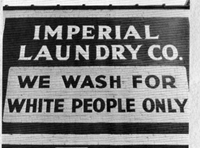  Black
Codes ceased after 1866, and were soon replaced by so-called
Jim Crow laws. These were state and local laws enacted up to
1965. They mandated racial segregation in all public facilities
in Southern states of the former Confederacy, with, starting
in 1890, a "separate but equal" status for African
Americans. The separation in practice led to conditions for
African Americans that were inferior to those provided for white
Americans, instituting a number of economic, educational and
social disadvantages. Northern segregation was generally less
formal, with segregation in housing enforced by covenants, bank
lending practices, job discrimination, and segregation. Jim
Crow laws required the segregation of public schools, public
places, public transportation, public lavatories, restaurants,
and even required separate public drinking fountains for whites
and blacks. The US military was also segregated. Black
Codes ceased after 1866, and were soon replaced by so-called
Jim Crow laws. These were state and local laws enacted up to
1965. They mandated racial segregation in all public facilities
in Southern states of the former Confederacy, with, starting
in 1890, a "separate but equal" status for African
Americans. The separation in practice led to conditions for
African Americans that were inferior to those provided for white
Americans, instituting a number of economic, educational and
social disadvantages. Northern segregation was generally less
formal, with segregation in housing enforced by covenants, bank
lending practices, job discrimination, and segregation. Jim
Crow laws required the segregation of public schools, public
places, public transportation, public lavatories, restaurants,
and even required separate public drinking fountains for whites
and blacks. The US military was also segregated.
  In
the USA where Christian values were strongest, millions of whites
belonged to the Ku Klux Klan, an organisation extolled by all
manner of Protestant churchmen. The Klan was then, and still
is now, a powerful advocate for Christianity. The Christian
cross features heavily in its activities and it has consistently
campaigned for the compulsory teaching of Christianity in public
schools. The Klan was so well accepted as a desirable part of
Christian American life that it commonly featured in the media
— both factual and fictional. In
the USA where Christian values were strongest, millions of whites
belonged to the Ku Klux Klan, an organisation extolled by all
manner of Protestant churchmen. The Klan was then, and still
is now, a powerful advocate for Christianity. The Christian
cross features heavily in its activities and it has consistently
campaigned for the compulsory teaching of Christianity in public
schools. The Klan was so well accepted as a desirable part of
Christian American life that it commonly featured in the media
— both factual and fictional.
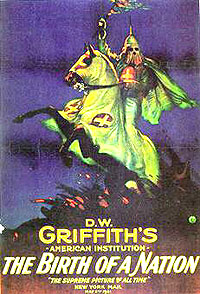  The
Rev. Thomas Dixon's novel The Clansman, for example
was made into an influential film in 1915: Also known as The
Birth of a Nation it is W. Griffith's famous work, which
explicitly glorifies the Klan. (The film is now rarely shown,
and then only with heavy cuts). In the early 1920s the Klan
boasted over 4,000,000 members, every one of them a practicing
Christian. Woodrow Wilson, in his History of the American
People referred to the film as "great" and described
it as"terribly true". The
Rev. Thomas Dixon's novel The Clansman, for example
was made into an influential film in 1915: Also known as The
Birth of a Nation it is W. Griffith's famous work, which
explicitly glorifies the Klan. (The film is now rarely shown,
and then only with heavy cuts). In the early 1920s the Klan
boasted over 4,000,000 members, every one of them a practicing
Christian. Woodrow Wilson, in his History of the American
People referred to the film as "great" and described
it as"terribly true".
The constitutionality of anti-miscegenation laws was upheld
by the US Supreme Court in the 1883 case Pace v. Alabama (106
US 583). The Supreme Court ruled that the Alabama anti-miscegenation
statute did not violate the Fourteenth Amendment to the United
States Constitution. According to the court, both races were
treated equally, because whites and blacks were punished in
equal measure for breaking the law against interracial marriage
and interracial sex. Between 1913 and 1948, 30 out of the then
48 states enforced anti-miscegenation laws.
|
Ku Klux Klan Wedding in Sedro Wooley
Washington, 16 June,1926
|
|
|
|
|
|
News in Philadelphia, 1867
|
|
|
  When
Martin Luther King wrote his famous "Letter from a Birmingham
Jail" in 1963 he was politely rebuking his fellow clergymen
from Alabama for their failure to support even nonviolent protest
against the racist enormities that were then everyday realities.
The letter refers to "the Negro church" and "the
white church" - a distinction that was taken for granted
by all. Here are a few of his comments directed, remember, to
clergymen who were his nominal allies: When
Martin Luther King wrote his famous "Letter from a Birmingham
Jail" in 1963 he was politely rebuking his fellow clergymen
from Alabama for their failure to support even nonviolent protest
against the racist enormities that were then everyday realities.
The letter refers to "the Negro church" and "the
white church" - a distinction that was taken for granted
by all. Here are a few of his comments directed, remember, to
clergymen who were his nominal allies:
Birmingham is probably the most thoroughly segregated city
in the United States. Its ugly record of brutality is widely
known. Negroes have experienced grossly unjust treatment in
the courts. There have been more unsolved bombings of Negro
homes and churches in Birmingham than in any other city in
the nation. These are the hard, brutal facts of the case.
On the basis of these conditions, Negro leaders sought to
negotiate with the city fathers. But the latter consistently
refused to engage in good faith negotiation. ... At first
I was rather disappointed that fellow clergymen would see
my nonviolent efforts as those of an extremist.
...
I have been so greatly disappointed with the white church
and its leadership.
...
When I was suddenly catapulted into the leadership of the
bus protest in Montgomery, Alabama, a few years ago, I felt
we would be supported by the white church. I felt that the
white ministers, priests and rabbis of the South would be
among our strongest allies. Instead, some have been outright
opponents, refusing to understand the freedom movement and
misrepresenting its leaders; all too many others have been
more cautious than courageous and have remained silent behind
the anesthetizing security of stained glass windows.
...
In the midst of blatant injustices inflicted upon the Negro,
I have watched white churchmen stand on the sideline and mouth
pious irrelevancies and sanctimonious trivialities. In the
midst of a mighty struggle to rid our nation of racial and
economic injustice, I have heard many ministers say: "Those
are social issues, with which the gospel has no real concern."
...
In deep disappointment I have wept over the laxity of the
church.
...
So often the contemporary church is a weak, ineffectual voice
with an uncertain sound. So often it is an archdefender of
the status quo. Far from being disturbed by the presence of
the church, the power structure of the average community is
consoled by the church's silent - and often even vocal - sanction
of things as they are.
...
But again I am thankful to God that some noble souls from
the ranks of organized religion have broken loose from the
paralyzing chains of conformity and joined us as active partners
in the struggle for freedom. They have left their secure congregations
and walked the streets of Albany, Georgia, with us. They have
gone down the highways of the South on tortuous rides for
freedom. Yes, they have gone to jail with us. Some have been
dismissed from their churches, have lost the support of their
bishops and fellow ministers.
(Click on this link to read
the full text)
|
Martin Luther King
removing a burnt Christian cross from his garden. In the
1960's Christian white supremicists like the Ku Klux Klan
often issued nocturnal warnings in the form of burning
Christian crosses.
|
|
|
  The
white Churches were slow to see that times were changing. State-sponsored
school segregation had been declared unconstitutional by the
Supreme Court in 1954 in Brown v. Board of Education.
Remaining Jim Crow laws would soon be overruled by the Civil
Rights Act of 1964 and the Voting Rights Act of 1965.
The ruling in Pace v. Alabama was overturned in 1967
in the case of Loving v. Virginia, where the Supreme
Court declared anti-miscegenation laws a violation of the Fourteenth
Amendment and therefore unconstitutional. The
white Churches were slow to see that times were changing. State-sponsored
school segregation had been declared unconstitutional by the
Supreme Court in 1954 in Brown v. Board of Education.
Remaining Jim Crow laws would soon be overruled by the Civil
Rights Act of 1964 and the Voting Rights Act of 1965.
The ruling in Pace v. Alabama was overturned in 1967
in the case of Loving v. Virginia, where the Supreme
Court declared anti-miscegenation laws a violation of the Fourteenth
Amendment and therefore unconstitutional.
|
Christian era America
|
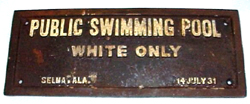  |
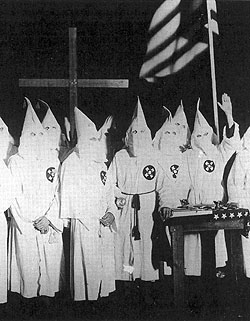  Segregation
remained longest in the USA where Christian belief was strongest.
Black people were denied education, the vote and civil rights.
Segregation was the norm in health care, in church, on public
transport, in places of entertainment, housing — almost
every aspect of life. Various black rights groups and white
liberals brought the iniquity to public attention. In the course
of a few years public opinion shifted to such an extent that
discrimination was made illegal. Once again the most strongly
Christian states, like Alabama, fought a rearguard action in
the name of God, and interracial marriage remained illegal in
19 heavily Christian states until 1967*. Segregation
remained longest in the USA where Christian belief was strongest.
Black people were denied education, the vote and civil rights.
Segregation was the norm in health care, in church, on public
transport, in places of entertainment, housing — almost
every aspect of life. Various black rights groups and white
liberals brought the iniquity to public attention. In the course
of a few years public opinion shifted to such an extent that
discrimination was made illegal. Once again the most strongly
Christian states, like Alabama, fought a rearguard action in
the name of God, and interracial marriage remained illegal in
19 heavily Christian states until 1967*.
In the case that finally overturned mix-race marriage laws
the supreme Court cited the trial judge, Judge Leon M. Bazilein,
from the original case heard on 6 January, 1959, as follows:
Almighty God created the races white, black, yellow, Malay
and red, and he placed them on separate continents. And but
for the interference with his arrangement there would be no
cause for such marriages. The fact that he separated the races
shows that he did not intend for the races to mix.*
This was entirely in line with traditional Christian teaching
— it had been upheld for decades by Christian judges without
a second thought - but contrary to the minority secular humanist
position.
Governor Ross Barnett was one who believed that "God was
the original segregationalist. He made the white man white and
the black man black and did not intend them to mix." Dr
W M Caskey, a faculty member at Mississippi College (a Baptist
Christian institution) supported Barnet confirming that the
Bible teaches that God was the original segregationalist. (Joseph
Crespino, In Search of Another Country: Mississippi and the
Conservative Counterrevolution, p 69).
Theodore Bilbo was one of Mississippi's great Christian demagogues.
Bilbo won a U.S. Senate seat campaigning against various ill
doers, including skunks who steal Gideon Bibles from hotel rooms.
Bilbo was also a virulent racist. "I call on every red-blooded
white man to use any means to keep the niggers away from the
polls," Bilbo proclaimed during his successful reelection
campaign in 1946. He was a proud member of the Ku Klux Klan,
telling Meet the Press that year that no man can leave
the Klan. "He takes an oath not to do that. Once a Ku Klux,
always a Ku Klux." During a filibuster of an anti-lynching
bill, Bilbo claimed that the bill would
... open the floodgates of hell in the South. Raping, mobbing,
lynching, race riots, and crime will be increased a thousandfold;
and upon your garments and the garments of those who are responsible
for the passage of the measure will be the blood of the raped
and outraged daughters of Dixie, as well as the blood of the
perpetrators of these crimes that the red-blooded Anglo-Saxon
White Southern men will not tolerate.
For Senator Bilbo racism was a sincerely held religious belief.
In a book Take Your Choice: Separation or Mongrelization,
Bilbo wrote that "[p]urity of race is a gift of God . .
. . And God, in his infinite wisdom, has so ordained it that
when man destroys his racial purity, it can never be redeemed."
Allowing "the blood of the races [to] mix," was a
direct attack on the "Divine plan of God." There "is
every reason to believe that miscengenation and amalgamation
are sins of man in direct defiance to the will of God."
Bilbo was one of the South's most colorful racists, but hardly
alone in his Christian racism. As early as 1867, the Pennsylvania
Supreme Court had upheld segregated railway cars on the grounds
that the natural law which forbids racial intermarriage, and
that social amalgamation which leads to a corruption of races,
is as clearly divine as that which imparted to the races different
natures. The same rationale was later adopted by state supreme
courts in Alabama, Indiana and Virginia to justify bans on interracial
marriage, and by justices in Kentucky to support residential
segregation and segregated colleges.
In 1901, Georgia Governor Allen Candler defended unequal public
schooling for African Americans on the grounds that "God
made them negroes and we cannot by education make them white
folks." After the Supreme Court ordered public schools
to be integrated in the case of Brown v. Board of Education,
many segregationists cited their faith as justification for
official racism. Ross Barnett won Mississippi's governorship
in a landslide in 1960 after affirming that "the good Lord
was the original segregationist." Senator Harry Byrd of
Virginia relied on passages from Genesis, Leviticus and Matthew
when he spoke out against the civil rights law banning employment
discrimination and whites-only lunch counters on the Senate
floor.
Some Christian sects held out for longer. Bob Jones University
is a private non-denominational Protestant university in Greenville,
South Carolina, known for its conservative cultural and religious
positions. It excluded African Americans completely until the
early 1970s. Then it began permitting black students to attend
but only if they were married. In 1975, it amended this policy
to permit unmarried African American students, but continued
to prohibit interracial dating, interracial marriage, or even
being "affiliated with any group or organization which
holds as one of its goals or advocates interracial marriage."
Because of this, the Internal Revenue Service revoked Bob Jones'
tax-exempt status. That the IRS would no longer give tax subsidies
to racist schools, even though they claimed that their racism
was rooted in their religious belief, now became a rallying
point for the Christian Right. According to Paul Weyrich, the
conservative activist " the IRS' move against schools like
Bob Jones was the single most important issue driving the birth
of modern day religious conservatism. Weyrich described it as
the "federal government's move against the Christian schools."
When a legal case reached the Supreme Court in 1983, the Christian
University argued that IRS' regulations denying tax exemptions
to racist institutions "cannot constitutionally be applied
to schools that engage in racial discrimination on the basis
of sincerely held religious beliefs." The justices did
not agree.
|
Christian era America
|
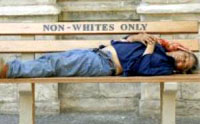 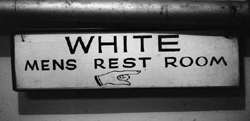 |
  The
Curse of Cain was used to support a ban on ordaining
blacks to most Protestant clergies until the 1960s in both the
US and Europe. Catholic dioceses in the Southern United States
adopted a policy of not ordaining blacks to oversee, administer
the Sacraments to, or accept confessions from white parishioners.
This policy was justified by the perceived threat of having
slaves rule over their masters. The
Curse of Cain was used to support a ban on ordaining
blacks to most Protestant clergies until the 1960s in both the
US and Europe. Catholic dioceses in the Southern United States
adopted a policy of not ordaining blacks to oversee, administer
the Sacraments to, or accept confessions from white parishioners.
This policy was justified by the perceived threat of having
slaves rule over their masters.
In 1995, the Southern Baptist Convention officially denounced
racism and apologized for its earlier defense of slavery. Other
Churches have made no apology for racism to anyone, though an
Archbishop of Canterbury, Dr williams, raised great controvery
by suggesting that missionaries in Africa had "sinned".
|
This cafe, like many others in the USA,
was strictly segregated - notice the signs over the two
doors
|
|
|
|
|
|
Christian racism in the USA extended
to anyone of the wrong religion or of non-European appearance
|
|
|
|
|
|
Shop owner, Kent, Washington,USA. March
2, 1944. United Press International (UPI)
|
|
|
Lynching
Lynching is the practice of murder by extrajudicial action.
Lynchings of black men, women and children by Christians occured
in the United States into the 1960s and beyond. Lynchings most
frequently targeted victims in the South, with mob actions attended
by an audience of hundreds or thousands. Lynchings in the latter
part of the 20th century began to be secretly conducted by smaller
groups.
|
Henry Smith was lynched at Paris, Texas,
in 1893. A large crowd followed the lynching, as was common
then in the style of public executions. Henry Smith was
fastened to a wooden platform, tortured for 50 minutes
by red-hot iron brands, and burned alive as more than
10,000 Christian spectators cheered.
|
|
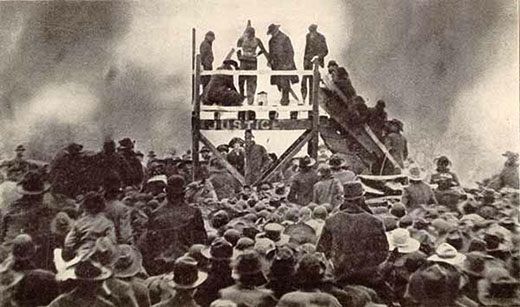
|
Other victims of lynching included other racial minorities
including Chinese and East Indian immigrants, Native Americans,
and Mexicans. In the South before the Civil War, members of
the abolitionist movement and others opposing slavery were also
sometimes targets of lynching and mob violence.
|
Christian era America
Frank Embree, having been stripped and whipped, about
to be lynched in Fayette, Missouri, USA, 1899.
|
|

|
Lynchings often involved torture, blinding, castration and
mutilation before the actual murder. Like official public executions,
Lynchings provided wholesome entertainment for all the family
- men, women and children. Newspapers not only advertised upcoming
lynchings, but also reported on them in the same way as sporting
events.
|
A double lynching in the Bible Belt
evidently occasioning a pleasant evening out for the white
locals
|
|
|
Participants were almost never brought to trial, and even fewer
were convicted by local courts., By the late 19th century, trial
juries in most of the southern United States were all white
because African Americans had been disenfranchised. Even where
the culprits were identified, no prosecutions were brought.
In 1892, a police officer in Port Jervis, New York, tried to
stop the lynching of a black man. Although at the inquest the
officer identified eight people who had participated in the
lynching, including the former chief of police, the jury determined
that the murder had been carried out "by person or persons
unknown.". A lynching in Fort Lauderdale, Florida changed
the political climate in Washington. On July 19, 1935, Rubin
Stacy,was taken into custody for vagrancy. While in custody,
a lynch mob took Stacy from the deputies and murdered him. The
faces of his murderers could be seen in a photograph taken at
the lynching site, yet the state still did not prosecute them.
The first Ku Klux Klan, a 100% Christian organisation, was
founded in 1866 and became associated with insurgent violence
against freedmen and their allies that included lynchings.
A South Carolina Christian governor and senator, speaking on
the floor of the U.S. Senate in 1900 said:
We of the South have never recognized the right of the negro
to govern white men, and we never will. We have never believed
him to be the equal of the white man, and we will not submit
to his gratifying his lust on our wives and daughters without
lynching him.
Young girl at the lynching of Rubin
Stacey in Fort. Lauderdale on July 19, 1935
As for well over a thousand years during the period
of Christian dominance, public executions provided entertainment
for all the family. Apart from publicly torturing the
the Mentally
Ill, it was pretty much the only permisable activity
that provided innocent family fun as well as delivering
a moral lesson.
|
|
|
At the start of the 20th century in the United States, lynching
was a popular subject for picture postcards. People sent postcards
of lynchings they had witnessed. A writer for Time magazine
noted in 2000,
Even the Nazis did not stoop to selling souvenirs of Auschwitz,
but lynching scenes became a burgeoning subdepartment of the
postcard industry. By 1908, the trade had grown so large,
and the practice of sending postcards featuring the victims
of mob murderers had become so repugnant, that the U.S. Postmaster
General banned the cards from the mails.
|
Christian era America - Lynching
|
|
|
Lynching photographs were printed for postcards, newspapers
and event mementos. Typically these images depicted the black
lynching victim and all or part of the white Christian crowd
in attendance. Spectators often included women and children.
Care seems to have been taken not to identify perpetrators of
lynchings. Often lynchings were advertised in newspapers prior
to the event in order to give photographers time to arrive early
and prepare their camera equipment. After the lynching, photographers
would sell their pictures as postcards, sometimes costing as
much as fifty cents a piece. Church services were sometimes
shortened to allow the congregation to get to the lynching in
time.
|
A cartoon from a Ku Klux Klan-related
newsletter, The Fiery Cross,
used as evidence in the civil trial that followed the
murder of Michael Donald
The box on the top-left reads "One
God, One Country, One Flag. For Christianity and Freedom"
|
|
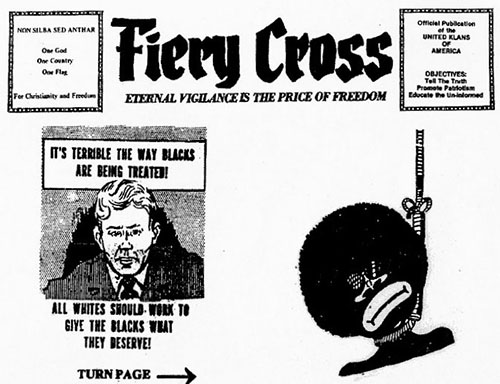
|
In Without Sanctuary (2000), a book of lynching postcards
collected by James Allen, Pulitzer Prize-winning historian Leon
F. Litwack wrote about the good churchgoing folk responsible
for the culture of lynching.:
"The photographs stretch our credulity, even numb our
minds and senses to the full extent of the horror, but they
must be examined if we are to understand how normal men and
women could live with, participate in, and defend such atrocities,
even reinterpret them so they would not see themselves or
be perceived as less than civilized. The men and women who
tortured, dismembered, and murdered in this fashion understood
perfectly well what they were doing and thought of themselves
as perfectly normal human beings. Few had any ethical qualms
about their actions. This was not the outburst of crazed men
or uncontrolled barbarians but the triumph of a belief system
that defined one people as less human than another. For the
men and women who composed these mobs, as for those who remained
silent and indifferent or who provided scholarly or scientific
explanations, this was the highest idealism in the service
of their race. One has only to view the self-satisfied expressions
on their faces as they posed beneath black people hanging
from a rope or next to the charred remains of a Negro who
had been burned to death. What is most disturbing about these
scenes is the discovery that the perpetrators of the crimes
were ordinary people, not so different from ourselves –
merchants, farmers, laborers, machine operators, teachers,
doctors, lawyers, policemen, students; they were family men
and women, good churchgoing folk who came to believe that
keeping black people in their place was nothing less than
pest control, a way of combating an epidemic or virus that
if not checked would be detrimental to the health and security
of the community."
From 1882 to 1968, "...nearly 200 anti-lynching bills
were introduced in Congress, and three passed the House. Seven
presidents between 1890 and 1952 petitioned Congress to pass
a federal law."] No bill was approved by the Senate because
of the opposition of the Southern Democratic voting bloc. Christian
Southern Senators held a hammerlock on Congress. Because of
the Southern Democrats' disfranchisement of African Americans
in Southern states at the start of the 20th century, Southern
whites for decades had nearly double the representation in Congress
beyond their own population. Southern states had Congressional
representation based on total population, but essentially only
whites could vote and only their issues were supported. Due
to seniority achieved through one-party Democratic rule in their
region, Southern Democrats controlled many important committees
in both houses. Southern Democrats consistently opposed any
legislation related to putting lynching under Federal oversight.
In the 1930s, virtually all Southern senators (all Christian),
blocked the proposed Wagner-Costigan bill. The political climate
of Christian America became even more surreal when later the
FBI branded Albert Einstein a communist sympathizer, for joining
Paul Robeson's American Crusade Against Lynching.
|
The lynching of Laura Nelson in Okemah,
Oklahoma, on 25 May, 1911
|
|
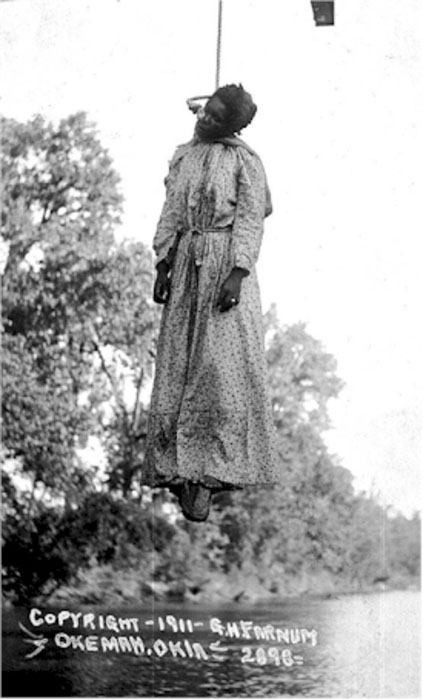
|
On June 13, 2005, the U.S. Senate formally apologized for its
failure to enact a federal anti-lynching law in the early 20th
century, "when it was most needed." Before the vote,
Louisianan senator Mary Landrieu noted, "There may be no
other injustice in American history for which the Senate so
uniquely bears responsibility." The resolution expressed
"the deepest sympathies and most solemn regrets of the
Senate to the descendants of victims of lynching, the ancestors
of whom were deprived of life, human dignity and the constitutional
protections accorded all citizens of the United States".
|
Lynching - everyone ever convicted
of lynching in the USA has been a devout Christian
Some of them have been Christian ministers and pastors
|
|
|
|
The records of Tuskegee Institute remain the single most complete
source of statistics and records on this crime since 1882 for
all states, although modern research has illuminated new incidents
in studies focused on specific states in isolation. As of 1959,
which was the last time that Tuskegee Institute's annual report
was published, a total of 4,733 persons had died by lynching
since 1882. To quote the report, A five-year study published
in 2015 by the Equal Justice Initiative found that nearly 3,959
black men, women, and children were lynched in the twelve Southern
states between 1877 and 1950. More than 85 percent of the estimated
5,000 lynchings in the post-Civil War period occurred in the
heavily and avowedly Christian Southern states.
Conclusions of numerous studies since the mid-20th century
have found five variables affecting the rate of lynchings in
the South, one of them keen competition between churches.
"lynchings were more numerous where the African American
population was relatively large, the agricultural economy
was based predominantly on cotton, the white population was
economically stressed, the Democratic Party was stronger,
and multiple religious organizations competed for congregants."
"religious organisations" is of course a euphemism
for "Churches".
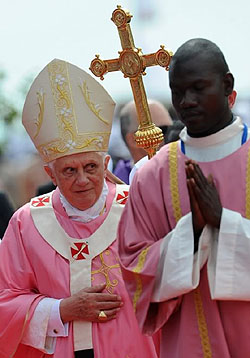  Christian
Racism in Modern Times Christian
Racism in Modern Times
It had become clear by the mid-1960s that world opinion was
moving away from the traditional Christian acceptance of discrimination.
In the future racist views were going to be politically and
socially unacceptable. If the Churches continued to hold to
traditional views they were likely to be left out on a limb.
Suddenly most world Churches became aware of a new duty in the
field of race relations.
Now that the tide of battle had turned, they declared their
opposition to all kinds of racism. To prove how deeply they
held their new beliefs they appointed black priests and bishops,
and joined in the badgering of those who stayed constant to
the beliefs that they themselves had just abandoned. Ten years
earlier, many had shared with Mormons the view that black people
were descended from Cain. He and his descendants had been cursed
by the Lord with a black skin and prohibited from the priesthood*.
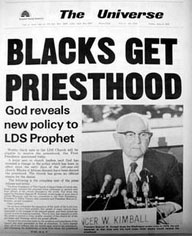  This
sort of belief had been commonplace among white Christians —
Roman Catholics, Protestants, Baptists and other nonconformists
alike. Now it was no longer acceptable to say such things openly. This
sort of belief had been commonplace among white Christians —
Roman Catholics, Protestants, Baptists and other nonconformists
alike. Now it was no longer acceptable to say such things openly.
Mormons were pressed to fall into line with the new orthodoxy.
They held out for as long as they could. Then God stepped in
(as he had previously done over polygamy) to announce a politically
astute change of policy.
In June 1978 the President of the Mormon Church announced a
divine revelation that reversed the Church's position. Black
people could now become full members of the Church.
|
The Dutch Reformed Church provided theological
(and biblical) justification for apartheid in Southy Africa.
|
|
|
.jpg)  Attention
next turned to the last bastion of Christian racism, South Africa.
Through the 1960s the Dutch Reformed Church claimed biblical
authority for the practice of apartheid, and no other Church
had seriously opposed it. As Dr Verwoerd, the Prime Minister
of South Africa had said "We did what God wanted us to
do"*. The position
had long been held by white Christians in South Africa, who
also supported the Curse of Ham theory*.
In the 1970s this line was no longer tenable. All other world
Churches had performed a volte-face and were now aligned
against their erstwhile ally. For a while the Dutch Reformed
Church held out on its own against its fellow Christian denominations,
still advocating the traditional Christian line. But the pressure
became stronger as the chorus against it became louder. Eventually
the Church gave way. By the 1980s it was assuring us that God
did not approve of apartheid after all: in fact he disapproved
of it. Within a generation the Church went from supporting apartheid
to condemning it as "the antichrist", just as other
Churches had done a few years earlier. Anglican and Roman Catholic
Churches even withdrew their full-time chaplains from the South
African armed forces*. Attention
next turned to the last bastion of Christian racism, South Africa.
Through the 1960s the Dutch Reformed Church claimed biblical
authority for the practice of apartheid, and no other Church
had seriously opposed it. As Dr Verwoerd, the Prime Minister
of South Africa had said "We did what God wanted us to
do"*. The position
had long been held by white Christians in South Africa, who
also supported the Curse of Ham theory*.
In the 1970s this line was no longer tenable. All other world
Churches had performed a volte-face and were now aligned
against their erstwhile ally. For a while the Dutch Reformed
Church held out on its own against its fellow Christian denominations,
still advocating the traditional Christian line. But the pressure
became stronger as the chorus against it became louder. Eventually
the Church gave way. By the 1980s it was assuring us that God
did not approve of apartheid after all: in fact he disapproved
of it. Within a generation the Church went from supporting apartheid
to condemning it as "the antichrist", just as other
Churches had done a few years earlier. Anglican and Roman Catholic
Churches even withdrew their full-time chaplains from the South
African armed forces*.
|
Christian era America - Ruby Nell Bridges
Hall (born September 8, 1954) in 1960 was the first black
child to attend an all-white elementary school in the
Southern states of the USA. She needed protection by US
marshals from White Christians (including parents and
teachers) who threatened to kill her.
William Frantz Elementary School, New Orleans, Louisiana
(Nov. 14th, 1960)
|
|
|
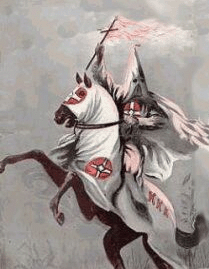  Since
the end of the 1960's the only remaining avowed white supremacists
in the world were Christians. The hard-core of white supremacists
in South Africa are still strong Christians, as are those in
other countries. In the UK the only political party that required
members to be Christian was the British National Party. In America,
Christians with traditional views kept alive the Ku Klux Klan.
The well-known cowls and robes worn by members are the traditional
garb of Christian penitents and pilgrims. The Christian cross
still plays an important rôle in their activities. They
proudly wear the emblem on their robes, and use burning crosses
to encourage a fear of God. They raise money for churches. They
donate bibles to schools. They are, they say, conducting a Christian
Crusade. This crusade has involved lynchings and bombings, and
arson attacks on black churches. The Macedonia Baptist Church
of South Carolina sued the Christian Knights of the Ku Klux
Klan in 1996 after members had been arrested in connection
with such arson attacks*.
As the Ku Klux Klan website still says in its homepage they
are “bringing a message of hope and deliverance for white
Christian America!”*.
In the twenty first century, Christian Klan members are still
engaging in activities such as arson attacks on non-white homes,
and participating in anti-immigration marches. Since
the end of the 1960's the only remaining avowed white supremacists
in the world were Christians. The hard-core of white supremacists
in South Africa are still strong Christians, as are those in
other countries. In the UK the only political party that required
members to be Christian was the British National Party. In America,
Christians with traditional views kept alive the Ku Klux Klan.
The well-known cowls and robes worn by members are the traditional
garb of Christian penitents and pilgrims. The Christian cross
still plays an important rôle in their activities. They
proudly wear the emblem on their robes, and use burning crosses
to encourage a fear of God. They raise money for churches. They
donate bibles to schools. They are, they say, conducting a Christian
Crusade. This crusade has involved lynchings and bombings, and
arson attacks on black churches. The Macedonia Baptist Church
of South Carolina sued the Christian Knights of the Ku Klux
Klan in 1996 after members had been arrested in connection
with such arson attacks*.
As the Ku Klux Klan website still says in its homepage they
are “bringing a message of hope and deliverance for white
Christian America!”*.
In the twenty first century, Christian Klan members are still
engaging in activities such as arson attacks on non-white homes,
and participating in anti-immigration marches.
|
Christian era America - Ku Klux Klan
campaigns are not always negative;
They have supported Christian causes since their foundation.
|
|
|
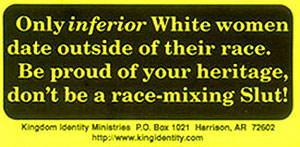  In
many places throughout the world whites still go to one church,
and blacks to a different one on the other side of town. Christians
of one colour who try to attend Christian churches of another
are sent on their way, sometimes with a discreet word, sometimes
with a less discreet word. This practice is largely responsible
for the growth of separate white and black Churches. So it is
that almost all of the 16 million members of the Southern Baptist
Convention in the USA happen to be white, although there are
roughly as many black Baptists in the country*.
Black churchgoers usually belong to all-black denominations*,
such as the National Baptist Convention in the USA. Black Roman
Catholics in the USA want a distinctive black American rite
and have periodically threatened to set one up, with or without
backing from the Vatican*.
As Martin Luther King observed, the USA is most segregated at
11am on Sunday morning [when all good Christians are in their
own racially segregated churches]. In
many places throughout the world whites still go to one church,
and blacks to a different one on the other side of town. Christians
of one colour who try to attend Christian churches of another
are sent on their way, sometimes with a discreet word, sometimes
with a less discreet word. This practice is largely responsible
for the growth of separate white and black Churches. So it is
that almost all of the 16 million members of the Southern Baptist
Convention in the USA happen to be white, although there are
roughly as many black Baptists in the country*.
Black churchgoers usually belong to all-black denominations*,
such as the National Baptist Convention in the USA. Black Roman
Catholics in the USA want a distinctive black American rite
and have periodically threatened to set one up, with or without
backing from the Vatican*.
As Martin Luther King observed, the USA is most segregated at
11am on Sunday morning [when all good Christians are in their
own racially segregated churches].
|
White Supremacist Christians are still
active in the USA
|
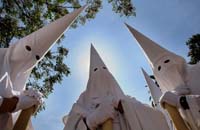 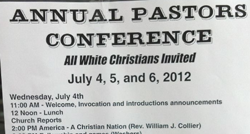 |
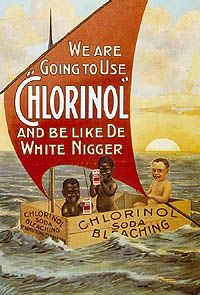  Effects
of traditional Christian attitudes to racial matters still continue
today: they cannot be obliterated in a single generation. When
Ugandan born Dr John Sentanu was enthroned as Archbishop of
York in 2005 he received a hail of insulting racist letters
some of them smeared with excrement*.
They presumably came from Anglicans, and possibly from other
Christians, as non-Christians would not have reason to care.
Sociological studies in Britain and the USA have demonstrated
that Christians still tend to be more racially prejudiced than
non-Christians. In a book comparing the results of studies concerning
prejudice, the authors state that "The basic finding that
church members are more prejudiced than non-members has been
widely confirmed in American studies"*.
According to these studies Roman Catholics were the most prejudiced
major denomination in the US. Similar studies showed that Anglicans
were the most prejudiced in Britain*.
In another study, religious orthodoxy was found to be positively
correlated with belief in racial segregation*. Effects
of traditional Christian attitudes to racial matters still continue
today: they cannot be obliterated in a single generation. When
Ugandan born Dr John Sentanu was enthroned as Archbishop of
York in 2005 he received a hail of insulting racist letters
some of them smeared with excrement*.
They presumably came from Anglicans, and possibly from other
Christians, as non-Christians would not have reason to care.
Sociological studies in Britain and the USA have demonstrated
that Christians still tend to be more racially prejudiced than
non-Christians. In a book comparing the results of studies concerning
prejudice, the authors state that "The basic finding that
church members are more prejudiced than non-members has been
widely confirmed in American studies"*.
According to these studies Roman Catholics were the most prejudiced
major denomination in the US. Similar studies showed that Anglicans
were the most prejudiced in Britain*.
In another study, religious orthodoxy was found to be positively
correlated with belief in racial segregation*.
|
Ideas like this can easily be found on
traditionalist white-supremicist Christian websites.
According to their ideas Adam and Eve were white, and
created after other races which all
consist of soulless hominids - so they are not truly human
|
|
|
More Examples
|
. A Merrie Melodies animated cartoon
directed by Bob Clampett, produced by Leon Schlesinger
Productions, and released to theatres on January 16, 1943
by Warner Bros. Pictures and The Vitaphone Corporation.
Lobby card 1942. the cartoon is one of the "Censored
Eleven", a group of Looney Tunes and Merrie Melodies
cartoons that were withheld from syndication by United
Artists in 1968.
|
|
|
| |
|
White Anglo-Saxon Protestants (WASPs)
in the USA were equally horrified by their predominently
Protestant country being overrun by Irish Catholics from
the West on the one hand, and Chinese heathens from the
East.on the other.
|
|
|
| |
|
From the The Dake Annotated Reference
Bible - an annotated version of the Kings James'Bible.
Notes on Acts 17:26 expand upon God's insistence that
different races should be segregated. Such notes were
typical in many bibles. The Dake Annotated Reference Bible
(1963) was the first widely published study bible produced
within the Pentecostalist community.
|
|
|
| |
|
Caracatures of Chinese Americans
|
|
|
| |
|
Jim Crow. The name "Jim Crow"
has been attributed to "Jump Jim Crow", a song-and-dance
caricature of blacks performed by a white actor, Thomas
D. Rice, in blackface. It was used in 1832 to satirize
Andrew Jackson's populist policies. "Jim Crow"
soon become a pejorative expression meaning "Negro"
by 1838. When southern legislatures passed laws of racial
segregation directed against blacks during the 19th century,
they came to be referred to as Jim Crow laws.
|
|
|
| |
|
Noddy Makes a Mistake
|
|
|
| |
| |
|
|
|
|
| |
|
Christian era America - Coon Chicken
Inn was an American chain of restaurants founded by Maxon
Lester Graham and Adelaide Burt in 1925. It featured a
characature, shown below, and prospered until the late
1950s.
|
|
|
|
|
| |
|
Christian era America
|
|
|
|
|
|
Christian era America
|
|
|
| |
|
Christian era America
|
|
|
|
|
|
St Nicolaasfeest
|
|
|
|
|
Christian era America - Circa 1920.
The Texas Restaurant Association posted these signs
at the entrances and exits to all restaurants in the
state.
|
|
|
|
|
|
|
Christian era America - Old B &
O Railroad Sign For Sale
|
|
|
|
|
|
Christian era America
|
|
|
|
|
Durban, South Africa, 1960's
|
|
|
|
|
|
Christian era America - Grand Theatre,
Birmingham, Alabama, USA, 1931
|
|
|
|
|
The Cape, South Africa, 1960's
|
|
|
|
|
|
Christian era America
|
|
|
|
|
|
Durban, South Africa, 1960's
|
|
|
|
|
|
Christian era America - Dimmit, Texas,
1949
|
|
|
|
|
|
"We don't want any Japs back here
- EVER", ca. March 2, 1944
http://www.corvalliscommunitypages.com/handcraftsallnew18.htm
|
|
|
|
|
|
Christian era America
|
|
|
|
|
|
Christian era America - A sign in Jackson,
Mississippi, photographed in 1961
|
|
|
|
|
|
Christian era America - A redesigned
museum at Ferris State University in Michigan collects
old and new racist objects
|
|
|
|
|
|
Christian era America
|
|
|
|
|
|
Christian era America - Early Nineteenth
Century Advertisements
|
|
|
|
|
|
Christian era America - Hendlers Ice
Cream Advertisement
|
|
|
|
|
|
Christian era America - Mid Nineteenth
Century American Advertisements
|
|
|
|
|
|
Christian era America - Mid Nineteenth
Century American Advertisements
|
|
|
|
|
|
The Fall Creek Massacre was a slaughter
of nine Indians of uncertain tribal origin in 1824 by
white settlers in Madison County, Indiana. Seven white
men participated in the crimes. Four were captured and
charged with murder. All four were convicted and sentenced
to death by hanging.
It was the first documented case in which white Americans
were convicted, sentenced to capital punishment, and executed
for the murder of Native Americans under the law in the
United States of America
|
|
|
|
|
|
Christian era America - The Ku Klux Klan
|
|
|
|
|
|
Christian era America - The Ku Klux Klan
Enjoying Themselves. Bless!
|
|
|
|
|
|
Christian era America - Dorothy Counts,
one of the first black students to enter the newly desegregated
Harry Harding High School is mocked by whites on her first
day of school. (Douglas Martin)
|
|
|
|
|
|
Christian era - Pears Soap Ad
|
|
|
|
|
|
Christian era America - Texaco Advertisement
|
|
|
|
|
|
Christian era Canada - My Heart Is White
|
|
|
|
|
|
Christian era America - A caracatured
Chinaman eats rats
|
|
|
|
|
|
Christian era - Fairy Soap Advert
|
|
|
|
|
|
Christian era America - A Japanese family
returning home ( Seattle, Washington ) from a relocation
center camp in Hunt, Idaho on May 10, 1945
|
|
|
|
|
|
Christian era America - Ten Little Niggers
|
|
|
|
|
|
Christian era America - Simple Addition
by a Little Nigger was originally published circa 1874
by McLoughlin Brothers of New York.
You can still buy it from Barnes & Noble for $11.65.
|
|
|
|
|
This marker is in the Fairhaven neighborhood
of Bellingham, Washington, USA. Bellingham Mayor Dan
Pike issued a formal apology to the Chinese community
for the expulsion of their people,125 years ago.
Pike says the apology is meant to make
it clear: authorities now see the racist actions by
regional governments and their supporters more than
a century ago were wrong.. In 1885 and 1886, thousands
of Chinese immigrants were driven out of Puget Sound
towns during an economic downturn. The Christian community
argued that the new residents were taking jobs away
from (Christian) white people.
|
|
|
|
|
|
|
|
Christian era America - Ex-slaves attend
reunion. Washington D.C. – October, 1916
|
|
|
|
|
|
|
Reconstruction of mid-1820s LaLaurie
household in New Orleans
Marie Delphine LaLaurie (née
Macarty or Maccarthy, c. 1775 – c. 1842), more
commonly known as Madame LaLaurie, was a Louisiana-born
socialite and serial killer known for her involvement
in the torture and murder of slaves.
Born in New Orleans, LaLaurie married three times over
the course of her life. She maintained a prominent position
in the social circles of New Orleans until April 10,
1834, when rescuers responding to a fire at her Royal
Street mansion discovered bound slaves within the house
who showed evidence of torture over a long period. LaLaurie's
house was sacked by an outraged mob of New Orleans citizens,
and it is thought that she fled to Paris.
As of 2013, the Royal Street mansion was still a prominent
New Orleans landmark.
|
|
|
|
|
|
Christian era - Tintin in the Congo (French:
Tintin au Congo) is the second volume of The Adventures
of Tintin, the comics series by Belgian cartoonist Hergé.
Commissioned by the conservative Catholic Belgian newspaper
Le Vingtième Siècle for its children's
supplement Le Petit Vingtième, it was serialised
weekly from May 1930 to June 1931.
|
|
|
|
|
|
Christian era - Tintin fights natives
|
|
|
|
|
|
Christian era advertising - Nigger Milk
|
|
|
|
|
|
Christian era advertising - Nigger Head
Tees
|
|
|
|
|
|
Christian era America
|
|
|
|
|
|
Christian era America - dispossessing
the "First Nations"
|
|
|
|
|
|
Christian era America
|
|
|
|
|
|
|
|
|
|
|
|
Christian era advertising - The Jolly
Chinee
|
|
|
|
|
|
Christian era advertising - Peachtree
|
|
|
|
|
|
Christian era advertising - advertising
chicken?
|
|
|
|
|
|
Christian era advertising - soap advert
|
|
|
|
|
|
Christian era advertising - "beaten
and happy"
|
|
|
|
|
|
Christian era advertising - white paint
|
|
|
|
|
|
Christian era advertising - soap advert
|
|
|
|
|
|
Christian era advertising - ginger
|
|
|
|
|
|
Christian era advertising - Chlorinol
|
|
|
|
|
|
Christian era advertising - Dixie Boy
|
|
|
|
|
|
Caricature of Bismarck cutting up Africa
between the European nations at the Conference of Berlin
|
|
|
|
|
|
Christian era America - Washington Post,
Oct. 27, 1895
|
|
|
|
|
|
Christian era America -Tuskegee Syphilis
Experiment (1933)
The Tuskegee syphilis experiment was
a clinical study conducted between 1932 and 1972 by the
U.S. Public Health Service to study the natural progression
of untreated syphilis in rural African-American men in
Alabama. They were told that they were receiving free
health care from the U.S. government. The Public Health
Service started working on this study in 1932 in collaboration
with the Tuskegee Institute, a historically black college
in Alabama. Investigators enrolled in the study a total
of 600 impoverished male sharecroppers from Macon County,
Alabama. Of the 600, 399 had previously contracted syphilis
before the study began, and 201 did not have the disease.
The men were given free medical care, meals, and free
burial insurance for participating in the study. None
of the men infected was ever told he had the disease,
nor was any treated for it with penicillin after this
antibiotic became proven for treatment. According to the
Centers for Disease Control, the men were told they were
being treated for "bad blood", a local term
for various illnesses that include syphilis, anemia, and
fatigue. The 40-year study was controversial for reasons
related to ethical standards, primarily because researchers
knowingly failed to treat patients appropriately after
the 1940s validation of penicillin as an effective cure
for the disease they were studying. In 1964 the World
Health Organization's Declaration of Helsinki specified
that experiments involving human beings needed the “informed
consent” of participants. But no one appeared to
have reevaluated the protocols of the Tuskegee Study according
to the new standards and in light of treatment available
for the otherwise usually fatal disease.
Medical ethics considerations were limited
from the start and rapidly got worse. To ensure that the
men would show up for the possibly dangerous, painful,
diagnostic, and non-therapeutic spinal taps, the doctors
sent the 400 patients a misleading letter titled "Last
Chance for Special Free Treatment". The study also
required all participants to undergo an autopsy after
death in order to receive funeral benefits. After penicillin
was discovered as a cure, researchers continued to deny
known effective treatment to many study participants.
Many were lied to and given placebo treatments so that
researchers could observe the full, long-term progression
of the fatal disease. The study continued, under numerous
US Public Health Service supervisors, until 1972. In July
25, 1972 the Tuskegee Study was reported by Jean Heller
of the Associated Press; the next day the New York Times
carried it on its front page, and the story captured national
attention. Peter Buxtun, a whistleblower who was a former
PHS interviewer for venereal disease, had leaked information
after failing to get a response to his protests about
the study within the department.
Victims of the study included numerous
men who died of syphilis, 40 wives who contracted the
disease, and 19 children born with congenital syphilis.
Revelations of study failures by a whistleblower led to
major changes in U.S. law and regulation on the protection
of participants in clinical studies. Now studies require
informed consent, communication of diagnosis, and accurate
reporting of test results.
|
|
|
|
|
|
Christian era advertising - Five Little
Nigger Boys
|
|
|
|
|
|
Christian era America - I Am A Man -
refering to the campaign for the abolition of slavery
|
|
|
|
|
|
Christian era advertising - Topsy Tobacco
|
|
|
|
|
|
Christian era advertising - Darkey in
a Watermelon
|
|
|
|
|
|
Christian era America - Housing segregation
in 1962
|
|
|
|
|
|
Christian era advertising - Nigger Head
Tar Soap
|
|
|
|
|
|
Christian era advertising - Dark Tan
|
|
|
|
|
|
Christian era advertising - Nigger Hair
Tobacco
|
|
|
|
|
|
Christian era America
|
|
|
|
|
|
Christian era America - September 15
1963 16th Street Baptist Church bombing:
White Christians murdering Black Children.
The 16th Street Baptist Church bombing was an act of white
Christian terrorism which occurred at the African-American
16th Street Baptist Church in Birmingham, Alabama on Sunday,
September 15, 1963. Four members of the strongly Christian
Ku Klux Klan planted at least 15 sticks of dynamite attached
to a timing device beneath the front steps of the church.
The explosion at the church killed four girls and injured
22 others. The FBI concluded in 1965 that the bombing
had been committed by four known Ku Klux Klansmen and
Christian segregationists: Bobby Frank Cherry; Thomas
Edwin Blanton, Jr.; Herman Frank Cash; and Robert Edward
Chambliss. Despite this, no prosecution ensued until 1977,
when Chambliss was tried and convicted of the first degree
murder of one of the victims, 11-year-old Carol Denise
McNair. Blanton and Cherry were each convicted of four
counts of murder and sentenced to life imprisonment in
2001 and 2002 respectively. Cash died in 1994 never having
been charged for is part in the bombing.
|
|
|
|
|
|
Christian era advertising - Water Mellon
Seeds
|
|
|
|
|
|
The Rwuandan Legacy - an echo of Belgian
attrocities
|
|
|
|
|
|
Christian era advertising - Rots of Ruck
|
|
|
|
|
|
Christian era America - Routine and widespread
racial discrimination
|
|
|
|
|
|
Christian era America - Negro Records
The Citizens' Councils (also referred
to as White Citizens' Councils) were an associated network
of white supremacist Christian organizations in the United
States, concentrated in the South. The first was formed
on July 11, 1954. With about 60,000 members, all over
the United States, but mostly in the South, the groups
were founded primarily to oppose racial integration of
schools, but they also supported segregation of public
facilities during the 1950s and 1960s. Members used intimidation
tactics including economic boycotts, firing people from
jobs, propaganda, and occasionally violence against civil-rights
activists. The successor organization to the White
Citizens' Councils is the Council of Conservative
Citizens, founded in 1985. It considers itself a traditional
conservative group opposing liberals and neo-conservatives.
. Its specific interests include race relations, especially
interracial marriage which it opposes, and conservative
Christian values.
|
|
|
|
|
|
Christian era advertising - Lord Have
Mecy
|
|
|
|
|
|
Christian era advertising - Pear's Soap
|
|
|
|
|
|
Christian era advertising - Pear's Soap
|
|
|
|
|
|
Christian era advertising - All Coons
Look Alike
|
|
|
|
|
|
Christian era advertising - Nigger Head
Oysters
|
|
|
|
|
|
Christian era advertising - Old Gold
Cigarettes
|
|
|
|
|
|
Christian era advertising - Nigger Hair
Tobacco was a brand that sold from 1878 up to the 1950’s.
During the 1950’s, the brand was renamed Bigger Hair
Tobacco after being pressured by the NAACP
|
|
|
|
|
|
Christian era advertising - Black-face
Minstrels
|
|
|
|
|
|
Christian era advertising - Nigger Make-up
|
|
|
|
|
|
Christian era advertising - Real Mayonnaise
|
|
|
|
|
|
Christian era advertising - Life Savers
|
|
|
|
|
|
Christian era advertising - Licorice
Drops
|
|
|
|
|
|
Christian era advertising - Nigger Head
Tobacco
|
|
|
|
|
|
Christian era advertising - Dat Nigger's
Eye
|
|
|
|
|
|
Christian era advertising - Javel
|
|
|
|
|
|
Christian era America - Housing Segregation
- a key selling point
|
|
|
|
|
|
Christian era advertising - The Coon's
Honeymoon
|
|
|
|
|
|
Christian era America - poster discouraging
integrated housing
|
|
|
|
|
|
Christian era America - 1967
|
|
|
|
|
|
Christian era advertising - Coon song
|
|
|
|
|
|
Christian era advertising - Stainilgo
|
|
|
|
|
|
Christian era advertising - Nigger Joe's
Tar Soap
|
|
|
|
|
|
Christian era America
|
|
|
|
|
|
Christian era advertising - Gollywog
|
|
|
|
|
|
|
|
|
More social issues:
|
|
|
|
|
|
|
|
|
|
|
|
|
|
|
|
|
|
|
|
|
|
|
|
|
|
|
|
|
|
|
|
|
|
|
|
|
|
Buy the Book from Amazon.com
|
|
|
|
|
|
Buy the Book from Amazon.co.uk
|
|
|
| |
| |
| More Books |
|
|
|